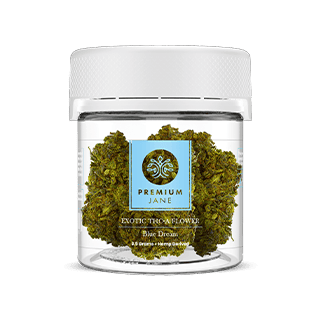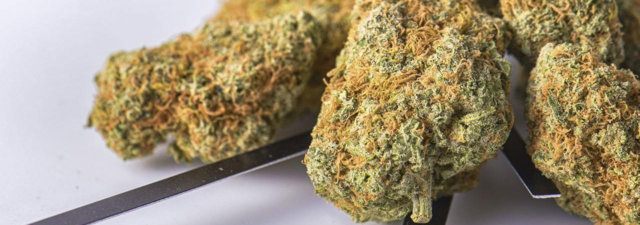Getting a cancer diagnosis is many people’s worst nightmare. Unfortunately, the side effects of cancer treatments like chemotherapy are equally difficult to handle. So, if you find yourself in this distressing situation, you might be wondering what you can do.
Luckily, over two-thirds of American states now have medical marijuana programs, with cancer frequently listed as a qualifying condition. While cannabis can’t cure cancer, it can potentially make coping with this diagnosis much easier.
In this article, we focus on some of the best marijuana strains for cancer treatment side effects. Read on to find out more about how they could help.

Want to experience the qualities of THC-A flower? The amazing brand Premium Jane just launched their new line, including strains like OG Kush, Purple Cream, and Blue Dream Pie. Averaging 23% THC-A, there’s so much to love with these flowers. Try them today to get 20% off using WayofLeaf’s exclusive coupon code: THCAWOL
What Is Cancer? Is Cannabis a Good Option for Cancer-Related Therapies?
Cancer involves a category of diseases in which cancerous cells develop and rapidly grow throughout the body. This rapid growth of abnormal cells is detrimental to healthy cells and their related organ and tissue systems.
Tumors are cancerous cell growths that can either be malignant or benign. Malignant tumors are capable of invading nearby tissues and spreading to other parts of the body. On the other hand, benign tumors do not spread to other parts of the body.
Benign tumors, once removed, generally are not life-threatening. Tumors within the brain are often an exception, wherein the mass needs to be urgently removed to prevent severe complications.
Cancer cells arise due to a malfunctioning within our DNA or genetic material.
Genes control how the body’s cells function; how they grow, divide, and even how they die. As cells divide, errors can occur within a person’s genetic makeup (genome), resulting in mutations. These types of mutations often serve as a catalyst for cancerous cell growth.
Some individuals may inherit faulty genetic programming from family members, making their cells more susceptible to mutations. Also, the DNA itself can become damaged due to environmental factors, such as exposure to radiation (including from the sun) and carcinogens – such as the smoke from cigarettes or other tobacco products.
There are plenty of carcinogenic (cancer-causing) substances within our day-to-day environment (including things like pollution) that could damage DNA and lead to mutations. Of course, just because someone is exposed to these substances does not guarantee they will acquire cancer in their lifetime.
Common Types of Cancer
Since cancer is a collection of uncontrollably reproducing cells, it can occur anywhere in the body and spread far from the point of origin – through organs, blood, bone, muscles, and even the lymph system.
What Is Breast Cancer?
Breast cancer is a common form of cancer among females, with an estimated 3 million women living with the condition in the United States alone. However, women are not the only individuals at risk; men can also develop breast cancer (about 2,500 males are diagnosed each year).

Breast cancer occurs when mammary cells start to spread rapidly and form tumors. These can be felt as lumps, which is why breast cancer screenings and routine check-ups are vital.
Like other forms of cancer, tumorous cell growths within breast tissue can either be malignant or benign. When malignant tumors in breast tissue invade other parts of the body, the process is known as metastasizing. Breast cancer is the second most common form of cancer amongst women in the world.
What Is Leukemia?
Leukemia is cancer that affects blood and marrow within the bones. Unfortunately, there is no known way to prevent leukemia from developing. Although many cases historically are seen among children, the fact is that more adults are diagnosed each year than kids.
Additionally, men are more likely to develop leukemia than are women, and Caucasians are more likely than African-Americans to be diagnosed. Leukemia is the tenth most common form of cancer amongst all genders and races.
Leukemia involves an overproduction of white blood cells in the bone marrow. White blood cells, or WBCs, are cells that help fight off infection. When WBC counts are off, the body cannot properly fight infection. Moreover, overproduction of cancerous white blood cells causes some, if not many, major organ systems to fail.
Leukemia patients often need blood transfusions and/or bone marrow transplants as part of treatment. Additionally, many leukemia patients must undergo chemotherapy or radiation treatment to kill the cancer cells in the blood and marrow.
What Is Skin Cancer?
An astonishing 1 in 5 Americans will develop a form of skin cancer at some point in their lifetime. Skin cancer occurs when there is an abnormal, uncontrollable growth of dermal cells. Often, these growths can be spotted in the form of an abnormal wart or mole that changes color, shape, texture, and/or size.
Skin cancer is known to be caused (among other reasons) by increased exposure to UV sunlight radiation, which damages DNA in the dermal layer. This triggers the onset of cellular mutations, resulting in the development of cancerous cells (again, growths can be either benign or malignant).
There are three common types of skin cancer:
- Melanoma
- Basal cell carcinoma
- Squamous cell carcinoma
Basal and squamous cell carcinoma are the two most common types of skin cancer and are heavily linked to UV exposure. Fortunately, these types are less likely to spread throughout other parts of the body. However, it is still vital to discover and treat them early so that no further cancer cells can grow.

Melanomas are rarer than basal and squamous cell skin cancers, but they tend to grow and spread quicker, making them far more dangerous. Melanoma can generally be taken care of in the early stages. However, if left alone or unchecked, melanoma can result in death.
Wearing sunscreen and/or sun protection can help prevent the development of skin cancer. Also, regularly checking for abnormal growths on the skin can offer the opportunity for early skin cancer detection, which is vital to decrease mortality rates.
Medical Marijuana and Cancer
Medical marijuana has proven beneficial for many cancer patients in terms of improving their overall quality of life. Medical cannabis can be specifically beneficial for the many adverse side effects that stem from radiation and chemotherapy. These side effects include lack of appetite, nausea, fatigue, and pain throughout the body

Let’s examine the research and studies to understand more about the evidence and effects of cannabis on cancer and cancer treatments.
Studies on Cannabis as a Potential Cancer Treatment for Chemotherapy Side Effects
1. Pain Relief
In a study published in the Journal of Pain and Symptom Management, researchers tested the pain-relieving effects of cannabis extract compared to placebo among 177 randomly selected subjects. Results of the study stated that “…THC:CBD extract of cannabis is efficacious for relief of pain in patients with advanced cancer pain not fully relieved by strong opioids.”
2. Nausea
Published in the BMJ scientific journal, researchers compared the effects of cannabinoids on chemotherapy-induced nausea to conventional nausea medicines. They concluded that “…cannabinoids were more effective antiemetics than prochlorperazine, metoclopramide, chlorpromazine, thiethylperazine, haloperidol, domperidone, or alizapride….” Also, patients preferred cannabinoids for future chemotherapy cycles.
3. Low Appetite, Anorexia, & Cachexia (Wasting Syndrome)
Dronabinol is a synthetic form of cannabis used primarily to treat patients experiencing anorexia and loss of appetite. The drug had its effectiveness reviewed and researched in a scientific article published in the Journal of Pain and Symptom Management.
While the study results were in specific reference to anorexic AIDS patients, the authors concluded that data supports “…long-term, safe use of dronabinol for anorexia associated with weight loss in patients with AIDS.”
4. Constipation or Diarrhea
A study published in The American Journal of Gastroenterology found that people who recently used cannabis were less likely to experience constipation. The researchers looked into the effect of marijuana use on bowel function. They identified over 9,600 adults aged 20 to 59 who completed bowel health and drug use questionnaires in the National Health and Nutrition Examination Survey from 2005-2010.
Overall, those who recently used cannabis experienced a lower level of constipation prevalence (7.5%) than people who never used the substance or hadn’t consumed it recently (10.2%). However, there was no association between recent cannabis use and diarrhea.
A review published in the International Journal of Molecular Sciences suggested that CBD could benefit patients with conditions such as IBS. However, the researchers acknowledged that far more data is necessary to confirm any such link.
5. Stress, Anxiety, and Depression
An increasing number of MMJ patients turn to cannabis to help combat stress, anxiety, and depression. One of the most interesting studies into the use of marijuana for such conditions was conducted by a Washington State University.

The study published in the Journal of Affective Disorders found that inhaling cannabis could reduce short-term levels of anxiety, stress, and depression significantly. However, there was a concern that long-term usage might contribute to more severe feelings of depression.
The research team discovered that a single puff of high CBD, low THC marijuana was optimal for reducing depression symptoms. Two puffs of any form of the drug helped with anxiety symptoms. Ten puffs of a high CBD, low THC cannabis strain led to the greatest reduction in stress. These findings suggest that MMJ patients should consider high CBD strains primarily if they’re looking for help with stress, anxiety, or depression.
6. Sleep Problems
Marijuana is also associated with helping people with insomnia go to sleep faster and sleep for longer. Most research to date champions high CBD strains for sleep. A review of studies on cannabis and sleep up until 2014 was published in Current Psychiatry Reports.
The researchers found that CBD had therapeutic potential for the treatment of insomnia. They also wrote that THC could decrease sleep latency but cause impairment to sleep quality in the long term.
A later case series published in The Permanente Journal looked into the effects of CBD and sleep. The researchers gave over 100 volunteers with sleep or anxiety problems CBD daily. After three months, 72 people completed the study. In two-thirds of the volunteers, sleep scores improved in the first month but fluctuated after that.
Best Strains for Cancer Patients
Once again, we’d like to point out that this article is not about using marijuana to treat cancer itself. Instead, we want to look into how it could help with the litany of adverse side effects that stem from various cancer treatments and medications.

We have highlighted several strains that traditionally help with nausea, pain, fatigue, and low appetite. All of these issues are common symptoms of cancer treatments such as radiation and chemotherapy. Now, let’s look at five such cannabis strains.
1. ACDC
ACDC is a relatively new cannabis strain that is classified genetically as a hybrid. It descends from the CBD-heavy marijuana strain known as Cannatonic and contains massive amounts of CBD.
This strain allows patients to experience the soothing benefits of CBD, which are potentially useful for numbing pain. In addition to featuring a prominent CBD content, the THC content of ACDC is quite low, ensuring minimal intoxication.

Cannabinoid Profile | 15-25% CBD, 0.5-1.3% THC.
How ACDC Could Help with Cancer Treatment Side Effects | Pain relief
2. Northern Lights
Northern Lights is an indica-dominant cannabis strain bred from a pure landrace Afghani indica and a Thai sativa. Due to its classic indica effects, Northern Lights can provide excellent nausea relief. Those who have undergone chemotherapy or radiation treatments for cancer often experience nausea as one of the primary adverse effects.
Smoking or otherwise consuming Northern Lights may help ease some of these discomforts and promote appetite.

Typical Cannabinoid Profile | CBD: Unknown (but not high); THC: 16-21%.
How Northern Lights Could Help with Cancer Treatment Side Effects | Nausea relief and improved appetite
3. Granddaddy Purple
A relaxing and calming indica strain that works well for sleep and sedation, Granddaddy Purple is another great option for nausea and low appetite.
The strain is a genetic cross between Big Bud (indica) and Purple Urkle (indica), making its indica dominance rather prominent. These classes of cannabis strains are notorious for promoting appetite and sedation. They’ll make you fall asleep fast, which is a major benefit for people recovering from cancer treatment.

Typical Cannabinoid Profile | CBD: 0.1%; THC: 17-23%.
How Grandaddy Purple Could Help with Cancer Treatment Side Effects | Improves appetite, promotes sleep and sedation
4. Chocolope
Chocolope is an energizing and uplifting sativa cannabis strain capable of awakening even the most fatigued of individuals. If you suffer from constant tiredness, specifically as a negative side effect from cancer treatment, Chocolope may be what you need to pick you back up.
As a genetic cross between Cannalope Haze and Chocolate Thai, Chocolope boasts intense sativa qualities. These often include a euphoric, mood-enhancing high and the development of a positive attitude and better outlook on life.

Typical Cannabinoid Profile | CBD: Unknown (but low); THC: 18-22%.
How Chocolope Could Help with Cancer Treatment Side Effects | Diminishes fatigue, boosts mood and energy, helps instill a positive attitude.
5. Charlotte’s Web
Because of its enormous CBD content (and low THC content), Charlotte’s Web is another strain that offers little to no mind-altering high. Commonly used by seizure patients, the hemp-derived Charlotte’s Web Cannabis Strain can also work well for pain and inflammation.
Typical Cannabinoid Profile | CBD: 20%; THC: 0.3%-1%.
How Charlotte’s Web Could Help with Cancer Treatment Side Effects | Pain and inflammation relief, improved mood
Summary: Top Strains for Cancer Treatment Side Effects (Chemotherapy, Radiation, & More)
Although research efforts in this space can always improve, studies involving cannabis for cancer-related treatment symptoms have shown positive results to date.
However, we must again emphasize that the strains listed above are not intended or recommended to treat any form of cancer. Rather, they may help deal with the varying adverse side effects of cancer treatments such as radiation and/or chemotherapy.
For individuals living in a state with a legal medical marijuana program, we advise applying for your medical cannabis card and speaking with a doctor about how cannabis may work for your specific needs.
Have vital information about cannabis and cancer treatments that you would like to share? Post your cannabis knowledge on our> FACEBOOK

Want to experience the qualities of THC-A flower? The amazing brand Premium Jane just launched their new line, including strains like OG Kush, Purple Cream, and Blue Dream Pie. Averaging 23% THC-A, there’s so much to love with these flowers. Try them today to get 20% off using WayofLeaf’s exclusive coupon code: THCAWOL




![Do Terpenes Get You High? [Understand the Facts!]](https://wayofleaf.com/wp-content/uploads/2019/08/mj_do_terpenes_get_you_high_1920-min-640x225.jpg)
![4 Best Cannabis Strains That’ll Melt Away Anxiety [Updated]](https://wayofleaf.com/wp-content/uploads/2019/06/wol-banner-4-strains-thatll-melt-away-your-anxiety-640x225.jpg)

![5 Best Cannabis Strains to Help Combat Nausea [Definitive Guide]](https://wayofleaf.com/wp-content/uploads/2019/02/wol_best-marijuana-strains-nausea-640x225.jpg)




![Marijuana for Athletes [How It Does the Body Good]](https://wayofleaf.com/wp-content/uploads/2018/01/wol_cannabis-for-athletes.jpg)
